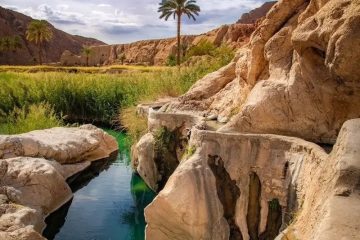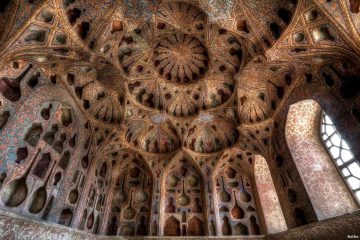The Empire of Beauty: One Thousand and One Nights
9 days/ 8 nights
“The Empire of Beauty: One Thousand and One Nights” is the third itinerary of the “Calm and Cultural” category that synthesizes two objectives in the same trip. By defining this style, we thought of attending to different needs and cultural tastes. In fact, each itinerary has its own characteristics, making the local culture alive with a particular strategy, created for the lovers of typical landscapes and wonderful cities of Iran. The highlight of this trip is to focus on the coalition between fairytale cities and picturesque landscapes. It offers travelers the opportunity to reflect during the tour and overnight stay in the most splendid cities of Iran.
Duration of trips is usually limited. Sometimes, there is no time for us to sit in a corner of the bazaar to have a coffee and contemplate the urban bustle, to stay in our room and rest, to stroll through popular neighborhoods or upper class areas, and to stand on the dunes of a desert or to stop in front of picturesque mountains to take a deep breath and take pictures. Many times it has happened to us that we had to refuse these whims and leave. The Calm and Cultural style is created precisely to meet these types of needs, although they may seem trivial, but they are precious for their influence on our memories of the trip. In proposing the theme “Calm and Cultural”, we have tried to give as much time as possible to observe the world around us without having the urge to leave or worrying about time. We thought of creating a less intensive and more relaxing itinerary so that we could walk slowly and contemplate the details of faces, cities and landscapes.
This category gives us the possibility of choosing both the type and duration of the trip. All you have to do is to decide on the dates and let us know the reason for your trip: relaxation, wedding, wedding anniversary, birthday celebration, engagement, etc. In addition to getting to know the most beautiful and fascinating places, our photographer will accompany you in order to photograph unforgettable moments throughout the trip.
What distinguishes this trip to Iran from others is the desire to return immediately to this country. The most striking point of the trip to Iran is undoubtedly the friendliness and hospitality of Iranian people who leave unforgettable memories deep down in the heart of travelers.
| DEPARTURE/RETURN LOCATION | IKA International Airport | ||||
| DEPARTURE TIME | Please arrive at least 2 hours before the flight. | ||||
| INCLUDED |
| ||||
| NOT INCLUDED |
|
1° Day; Country of origin - Tehran
Departure by scheduled flight to the capital of Iran, Tehran, located at the foot of Mount Alborz. Welcome and greetings by SITO TRAVEL’s tour guide at the airport. Transfer to hotel and check-in.
Azadi Hotel or similar hotels.
2° Day; Tehran
Breakfast. The day is dedicated to visit particular places of the Iranian megalopolis. Before we start, it is necessary to know that the Iranian Revolution (1979) is no the beginning of Iran’s history, but rather a milestone. The birth of modern Iran dates back to 1925, when Reza Pahlavi ascended the throne and the Qajar dynasty was deposed. During his ascension to the throne, Reza Shah had the support of the Shiite clergy, but once he came to power, he abandoned his alliance with the clergy and developed various campaigns to modernize and secularize the country. Thanks to oil revenues, the Shah was able to establish a new state based mainly on two pillars: the army and the bureaucracy.
In the morning, we head to the north of the city, a very interesting area to observe the architectural progress of modern Tehran. We will have the opportunity to visit the Niavaran Palace which, in the 60s, hosted the most important politicians of the world. After a lunch break in a typical restaurant in the middle-class district of Tehran, we continue to the lively Tajrish Bazaar and then return to the hotel walking along the beautiful tree-lined Valiasr Street.
- Niavaran Palace: has witnessed many of the events recounted in historical texts including the attempt to modernize ancient Persia, which ended dramatically, due to many fatal mistakes of the Shah. The palace was the last Mohammad Reza Pahlavi’s refuge before he fled the country. Walking through the corridors and rooms of the residence, we will discover the clothes and objects left by the Shah and his family before leaving Iran. This palace represents, briefly, a collection of historical objects telling us a fragment of the modern history of Iran before the Islamic Revolution. Among the exhibits are the pilot certificates of Mohammad Reza Shah’s son, the gifts given to the Shah’s sons, the moon fragment that Nixon gave to the Shah during an official visit, a painting of the queen, Farah Diba, smiling as she watches her son, Reza, in a pilot’s uniform, climbing a tree.
Today, Tehran play a pivotal role in Iran’s modern history as it offers travelers extraordinary sites, bars, parks and recreational areas. Iran’s concern of artistic developments, recent architectural interventions and the revival of many traditional style cafes has made the city a fascinating labyrinth that holds a surprise for visitors at every corner.
- In the afternoon, a pleasant walk across the Tabiat Bridge (Pol-e Tabiat), a modern landmark of the Iranian capital, Tehran. Tabiat Bridge is a pedestrian area, built on one of the main highways of the city connecting two green hills (two public parks). The bridge was designed by a 26-year-old Iranian woman, “Leila Araghian”. Since its inauguration in 2014, it has won many international awards. The designer has expressed that this work has been conducted with the purpose of bringing people together.
Later, we go to one of the cafes frequented by young artists, writers and inhabitants of the megalopolis on another side of the city.
- Niavaran Palace
- Lunch in a typical restaurant in Niavaran
- Tabiat Bridge
- Tehroon Café
3° Day; Tehran – Shiraz
Transfer to Mehrabad Airport to catch the domestic flight Tehran-Shiraz. Arrival in Shiraz. Transfer to hotel and check-in.
The city of Shiraz is the capital of the administrative region of Fars or Pars. A single moment of reflection on the last word is enough to realize that we are in the geographical heart of Iran’s history where the Persians built Parse, also known as Persepolis: the city of the Persians. The historical relevance of the region is not limited to the Achaemenid era, as Shiraz covers a vast historical axis that goes from the 4th century BC to the 1700s. In Shiraz, Persian poetry becomes truly tangible; the gardens, bazaars and mosques of its historic center, steeped in culture, embraces every visitor. The city’s inhabitants take refuge in their homes at noon to reappear around the Arg Citadel in the afternoon, where activity continues until late at night. The people of Shiraz are known for their taste for nature and picnic and are considered to be the liveliest and funniest people in the whole country.
To discover the Dionysian atmosphere of Shiraz (the name of the city says it all, as it refers to the shape of a snake), the traveler should not miss visiting the tomb of the Persian poet and mystic “Hafez” or wandering the alleys of the Vakil Bazaar where so many European traders came in search of the famous product of the god Bacchus. Understanding the poetic atmosphere of Shiraz will not be possible without visiting two splendid places in the city: the Eram Garden, a typical example of a Persian Garden, and the Tomb of Hafez.
- Tomb of Hafez: a Sufi mentor, the great poet of the 14th century A.D. The sweetness of Persian philosophy was born between the lines of Hafez’s poems. What immortalizes this poet is beyond the meaning of his poetry, his Sufi thought, which makes him outstanding for all readers. The surprise lies in the fact that Hafez’s words are related to Bacchus and Venus. Therefore, reading Hafez’s Divan is like taking a walk in his paradisiacal garden to understand the contradiction that exists between Dolce Stil Novo and modernity: it may seem a subversive poem!
- In the afternoon, we visit Vakil Bazaar: a unique construction that thanks to its brick architecture and vaulted roofs, fresh air circulates here in summer as well as in winter.
- Saray-e-Moshir Caravanserai: originally a traditional bazaar, it has been used as a museum and traditional restaurant and tea shop. After the Islamic Revolution it was closed for some years. It has become a place where handicrafts and products of all kinds are produced, located next to the Vakil Bazaar. A world of dreams that lets the imagination fly.
We will stop at a nearby café in Saray-e Israfil to get immersed in the poetic atmosphere and serenity of the city, having a saffron ice cream or bergamot infusion, the quintessential aroma of Shiraz. Within vicinity of Saray-e Israfil there are typical restaurants very suitable to dine and spend an evening in serenity.
- Domestic flight to Shiraz
- Eram Garden
- Tomb of Hafez
- Vakil Bazaar
- Saray-e Moshir Caravanserai
4° Day; Shiraz - Persepolis
After breakfast before departure to Yazd, we will visit the Nasir-ol-Molk Mosque in Shiraz, one of the most beautiful places during the trip to Iran.
- Nasir-ol-Molk Mosque: The term “elegance” finds its true meaning inside this sacred space with its splendid polychrome majolica tiles. The springtime of Shiraz is reflected surprisingly on the walls, stained glass windows and the exquisite tile decorations. This mosque, a masterpiece of the late 1900s, also known as the Pink Mosque, is a welcoming place where the chromatic world from the rose petals, iris and so on catches the eye at first glance.
- Qavam House (Narenjestan Garden): It dates back to the Qajar period (1880). The name of the garden “Narenjestan” comes from sour orange or bergamot trees, so we are not surprised that Shiraz is the most famous city for its bergamot trees found in the streets of the city. The pavilion in the middle of the garden was a place where people went for administrative purposes and public meetings were held, as well as those between dignitaries and nobles of Qajar.
- After lunch, departure to Persepolis: it is a sacred city founded by Darius I the Great in 524 BC to celebrate Nowruz festival (New Day), the Persian New Year, on 21st March. Persepolis was conquered and burned by Alexander the Great in the revenge for Xerxes’ plundering in the Median wars. The excursion to Persepolis explains in details this majestic city, built by the best craftsmen of the world who received wages and insurance according to the royal law. In this place, we will come to a deep understanding of its architecture by contemplating the wonderful bas-reliefs of the Apadana Palace.
Among the ruins, we can visit its imposing palaces that never fail to impress travelers: the Palace of 100 Columns where the King used to receive the generals and the Audience Hall of the Apadana Palace with a square plan and six rows of columns, up to 19 meters high, which includes the brilliant anti-seismic system to hold the ceiling in case of shock. The access stairways depict Satrap’s processions and the imperial guards called the Immortal soldiers.
At sunset, our photographer takes advantage of the perfect light to capture the best moments of the trip during the excursion to Persepolis.
Near to the archaeological site there is a historic structure acting as a hotel that once hosted archaeologists and team leaders working during the excavations of Persepolis in the 1930-40s. In the 1960s and 1970s, Mohammad Reza Pahlavi, the Shah of Iran, and his wife Farah Diba went to this hotel for the 2500 Years of the Persian Empire Celebration.
- Nasir-ol-Molk Mosque
- Narenjestan Garden
- Excursion to Persepolis
Dinner and overnight stay at Apadana Hotel
5° Day; Persepolis - Isfahan
After breakfast, we leave for Isfahan. The highlight of the itinerary is Isfahan. This city is a historical image that completes the journey in Iran. It is no coincidence that Isfahan attracted Pasolini’s attention to shoot some scenes of his film in Naqsh-e Jahan square. There is a Persian saying: “Isfahan is half of the world.” In fact, the flourishing of Islamic-Iranian architecture was born here in Naqsh-e Jahan Square where the turquoise blue dominates the domes of mosques and the sky above. Over time, the former polo field was converted into the home of valuable art workshops. The Safavid era corresponds to the third Persian Empire which restored Iran’s power and established a new country based on political, religious and military relations. The presence of Vank Cathedral (also called St. Savior’s Cathedral), run by the Armenian Christian community since 1605 AD makes a good example of this city. However, the Safavid power was represented through art and thus, a phase of “Renaissance” of Persian civilization, culture and art was born in Isfahan. The Islamic Renaissance period in Iran sees artistic lightning under the rule of the Shah Abbas I (1587-1629). In Isfahan, in a matter of seconds, every traveler’s dream of Middle East comes true: Iran and the appeal of the Renaissance, Chehel Sotun Palace and the magnificent ceiling of the Music Palace of Ali Qapu Mansion.
The afternoon is dedicated to visit the square and walk through the old Chaharbagh Boulevard leading to Si-o-Se Pol (33 Arches Bridge). In Isfahan, as one visit ends, another begins, and the traveler unconsciously prepares to listen to the city’s narratives, as if Scheherazade were reading them directly from “the Arabian Nights”.
Having walked across the ancient bridge, we will have dinner at a traditional restaurant in the historical center
- Chaharbagh Boulevard
- Si-o-Se Pol
Abbasi Hotel or similar hotels.
6° Day; Isfahan
- In the morning, we visit Royal Square or Naqsh-e Jahan: (the image of the world) located in the center of the city, was redesigned by Shah Abbas I. There are two arches in the large central square of Naqsh-e Jahan (512 by 163 meters). On the southern side, there are many handicraft stores selling miniatures, turquoise work, enamels and traditional fabrics. Naqsh-e Jahan Square was home to an elite of merchants who sought artistic refinement. In the square, there are still the pillars that served to delimit the Polo field built 400 years ago.
After visiting the square, we return to the hotel. In the afternoon, we go to the Armenian district of Jolfa.
Iran’s multi-ethnicity is a relevant factor in understanding Iran today. While some of today’s nomads have been living in the Iranian plateau for centuries, other ethnic groups such as Turkmens or followers of other religions, such as Christians, came to Iran for geopolitical reasons and recognized Iran’s tolerance towards other ethnicities and religions. One need only think of the particular case of the Armenians who were forced to move to Iran on the orders of Shah Abbas I. In fact, the Armenians of Jolfa region of Armenia, in the 1920s, left their homeland, devastated due to ongoing conflicts between the Ottomans and the Safavids, and after arriving in Isfahan, the Armenian patriarchate began a new socio-religious phase by setting up new headquarters and communities. The Jolfa district of Isfahan welcomed the Armenians, and Shah Abbas I, in a manuscript signed by himself, allowed them to establish new commercial and religious relations, giving them a certain freedom, fully supported by the Safavid court. The Armenians opened an important trade route in the heart of Isfahan, the Safavid capital. The headquarters of the Armenian caliphate was centralized mainly through the publication of new religious texts using the Gutenberg invention in Iran. The beauty of the architecture and the details of the murals in Vank Cathedral surprise any traveler.
The afternoon is dedicated to take a walk in Jolfa district and have a coffee or Iranian tea and for dinner we go to the other side of Jolfa to relax and contemplate other places frequented by young people.
- Naqsh-e Jahan Square
- Stroll through the Jolfa district
- Dinner at a restaurant in the Armenian quarter
7° Day; Isfahan - Natanz - Abyaneh - Kashan
In the late morning, departure to Natanz and then we continue the journey along the Karkas (vulture) Mountains to join an incredible adventure, walking through one of the oldest traditional villages of Iran, Abyaneh, in a valley. This village, with an altitude of more than 2200 meters above sea level, dates back to the Achaemenid era of the 4th century BC. Abyaneh, characterized by the red ochre color of the houses, is surrounded by the ruins of the Sassanid dynasty belonging to the 3rd century A.D. Another characteristic of this village is the rose pattern on the long white scarves of the women. (Depending on the season and the weather this visit can be included or excluded).
After visiting Abyaneh, we leave for Kashan.
Kashan always represents an exemplary model to learn more about its local culture. In addition to the existence of its millenary hill, Kashan is also known for its 19th century villas, also called bioclimatic houses. It is necessary to know that Kashan has a desert climate and very hot summers. The invention of the city’s inhabitants led to the birth of a house in two or three different levels making easy to cool or heat the rooms depending on the season. The importance of the city is not only based on the variety of houses, but it is mainly known for the production of high quality rose water. In fact, the trip to Iran now takes on its original scent of rose petals grown in the hills of central Iran. This beautiful city, located in a green oasis, still houses some of the most beautiful traditional houses in the area. The stay in Kashan consists of spending a peaceful night in a fairytale place or in 19th century villa that has preserved the bioclimatic criteria adapted to receive guests. Just before leaving for the desert, we will visit the ancient Sultan Amir Ahmad Bathhouse, the Safavid period thermal complex with a hydraulic system and a particular heating system. This thermal complex is divided into three different parts: frigidarium (the place to take cold baths), tepidarium (the room of warm baths) and caldarium (the room of hot bath). What highlights the beauty of this bathhouse is the decoration of the walls and the position of the pools in the first room. Each space was reserved exclusively for a particular social class: the descendants of the Prophet, clerics, nobles, merchants and farmers.
After visiting the bathhouse and taking a short break, we head to the popular and lively bazaar of Kashan, one of the most extended bazaars in Iran, which has retained its typical Iranian and Oriental Style. In fact, Saray-e Amin Oddoleh can be considered the most majestic courtyard of the bazaar surrounded by the city’s famous antique and carpet stores. In addition, next to the basin there is a café where you can have tea and contemplate the daily movements of people.
We return to the hotel for a serene night.
- Abyaneh
- Sultan Amir Ahmad Bathhouse
Dinner and overnight stay at Ameri’s House or Manuchehri’s House.
8° Day; Kashan - Qom - Tehran
- In Kashan, there is also Bagh-e Fin, one of the most famous Persian gardens you can visit during the trip to Iran. The Fin Garden was designed by Shah Abbas I (1557-1629), as an earthly vision of Paradise. The concept of the Persian garden appeals to the soul only by listening to the melody of spring water overflowing into different canals. Today, the central pond called “camel’s throat” (Shotor Galu) is responsible to distribute water to all side channels, using the simple theory of communicating vessels. In 16th century, the Persian Garden in Iran became particularly important as Shah Abbas I chose it as the ideal place for the royal coronation when he ascended the throne. Two centuries later, the Qajar kings also chose the Persian Garden of Fin as the operational headquarters of the court. Among the greenery of Fin Garden, only cypresses and sycamore trees can explain the symmetry and elegance of its design. On the other hand, there are some extraordinary frescoes from the Qajar era. To find out the secrets of the garden, we need to pass by the Fin Bath (Hammam-e Fin), known for the suicide, or rather, the assassination of Amir Kabir, the reformer of Qajar government.
We will also visit Agha Bozorg Mosque and Madrasa, a Koranic school whose architectural plan is very peculiar, built on several levels. Afterwards, we will observe the details of the bioclimatic architecture in a historical house and taste local delicacies.
After a short break and having a rosewater tea, it is time to leave for Qom, the second most sacred city of Iran dominated by Fatima Masumeh Shrine, sister of the eighth imam of the Shiites and descendant of the Prophet; Ali ibn Musa al-Reza, and daughter of the seventh imam, Musa ibn Ja’far. Fatima Masumah was born in 789 AD in Medina. On her way to Marv to visit her brother in 816, she became ill (or was injured during the looting of the caravan) and was taken from Saveh to Qom, where she died at the age of 27. Annually, thousands of Shiites from all over the Middle East take part in pilgrimage rituals at the Masumah shrine in Qom. In the shrine complex, there is a part called the burial chamber to which Muslims are allowed to have access.
As the sun sets and its rays brighten, the route back to Tehran becomes more noticeable, as if the journey to Iran has just started. It is time to pack the suitcase, which returns loaded with excitement, enthusiasm and a lot of culture. Normally, travelers worry about the cost of overloading their luggage, and as the color of the sky darkens, they are thinking about how to arrange souvenirs and gifts; they like to buy everything from pistachios to fabrics and turquoise stones. There is no doubt that everything will fit, except one thing: the hospitality of the people we met in the markets, historical sites and restaurants. This image is engraved in their hearts and is an unforgettable memory that the traveler will carry with him everywhere. Above all, it will be a good incentive for all those who have enjoyed this trip to return to Iran for the second time.
Transfer to Tehran airport, dinner and overnight stay at IBIS hotel.
- Agha Bozorg Mosque and Madrasa
- Fin Garden
- Having lunch in the Abbasi Historical House
- Qom
Tehran IBIS Hotel
9° Day; Tehran - Destination Country
Transfer to Imam Khomeini International Airport (IKA) departing Tehran to destination country.






Tour Reviews
There are no reviews yet.
Leave a Review
Show reviews in all languages (2)